Powis Castle | Visit Amazing Welsh Castles
Powis Castle is a medieval fortress with later additions, situated near Welshpool in Powys, Wales. It is well known for its striking red sandstone walls and extensive formal gardens.
The castle has changed ownership several times, reflecting a long and complex history. Today, it functions as a museum managed by the National Trust, with interiors showcasing the Clive Museum collection, including artefacts from India. It offers a combination of architectural history and horticultural interest, making it a prominent destination for history enthusiasts and garden visitors alike.
Quick Facts
Location: Welshpool, Powys, Wales
Type: Medieval castle with later country house additions
Built: Late 13th century
Current Use: National Trust property, museum, and gardens
Original Purpose: Fortress of the Welsh Princes of Powys
Key Features: Medieval architecture, Baroque state rooms, Clive Museum, terraced gardens
Dog Friendly: Dogs allowed on lead in the courtyard and parkland, but not in the formal gardens or castle interiors
Managed By: National Trust
Brief History
It was constructed in the late 13th century by the Welsh rulers of Powys, specifically the dynasty known as Mathrafal. The castle served as a stronghold against both English incursions and rival Welsh princes. Its early role was defensive, controlling the Severn Valley and maintaining local authority.
During the 16th century, the Herbert family, descendants of Welsh nobility, acquired the castle. They converted the medieval fortress into a stately country residence. Significant alterations included the addition of comfortable living spaces and formal gardens, reflecting the changing function of the castle from fortress to noble residence.
In the 18th century, the castle passed through marriage to the Clive family. Robert Clive, known as “Clive of India,” brought considerable wealth to the estate. His descendants used this wealth to expand the castle’s collections, including art and artefacts from South Asia.
The 20th century saw the castle’s transfer to the National Trust in 1952 by George Herbert, 4th Earl of Powis. This secured its preservation and public access. Today, it continues to display influences from its medieval, Tudor, and Georgian phases, alongside important historical collections from the British colonial period.
Features and Layout
The castle combines medieval fortifications with later domestic and decorative features. Its structure follows a traditional medieval design, centred around a courtyard enclosed by high red sandstone walls. The oldest parts of the castle include the medieval keep and defensive towers, which remain largely intact.
The castle interior reflects several centuries of architectural changes. The state rooms feature Baroque-style decorations, including richly decorated ceilings, tapestries, and ornate furniture. The Clive Museum, housed within the castle, contains a large collection of artefacts from India, including weapons, ceremonial objects, and textiles.
The terraced gardens are one of the castle’s most distinctive features. Designed during the 17th and 18th centuries, they include Italianate terraces, statues, formal flowerbeds, and yew hedges. The gardens extend down steep slopes, offering views across the Severn Valley.
Stone staircases within the castle show signs of centuries of use, with worn steps and handrails. Visitors can also see the original medieval dungeons, although many of the castle’s defensive features have been repurposed over time.
Did You Know?
Powis Castle contains a world-famous collection of Indian artefacts in the Clive Museum. This includes Tipu Sultan’s campaign tent, one of the largest surviving pieces of Mughal-era textile craftsmanship.
Images
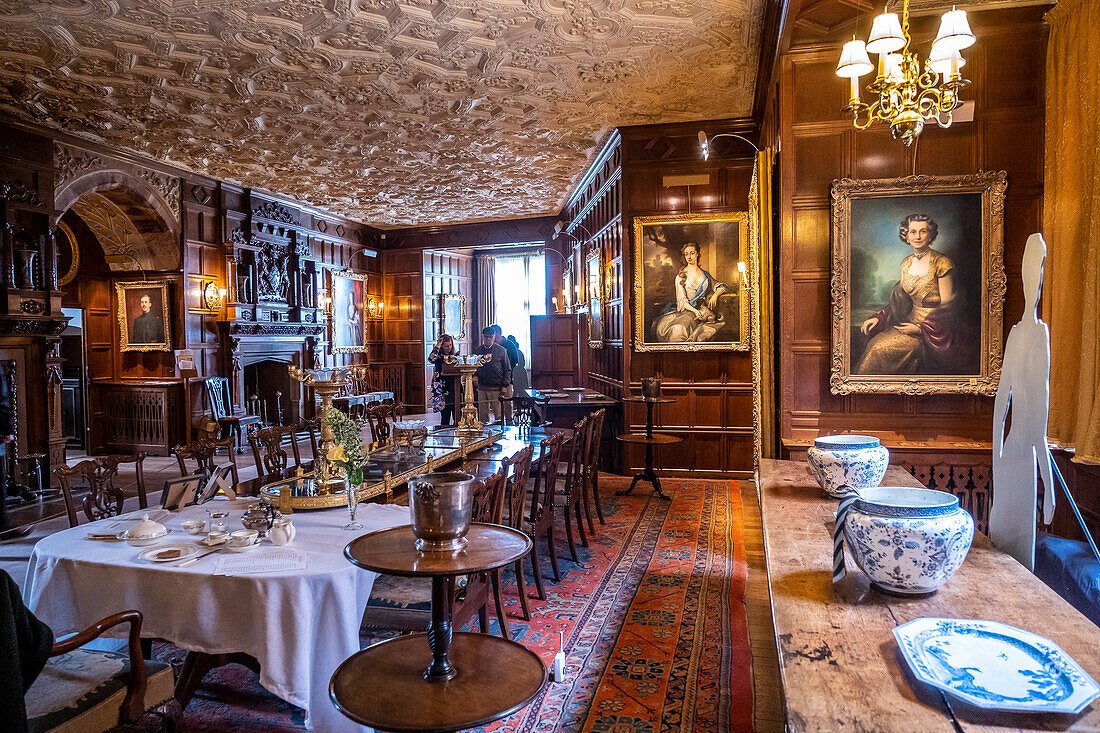
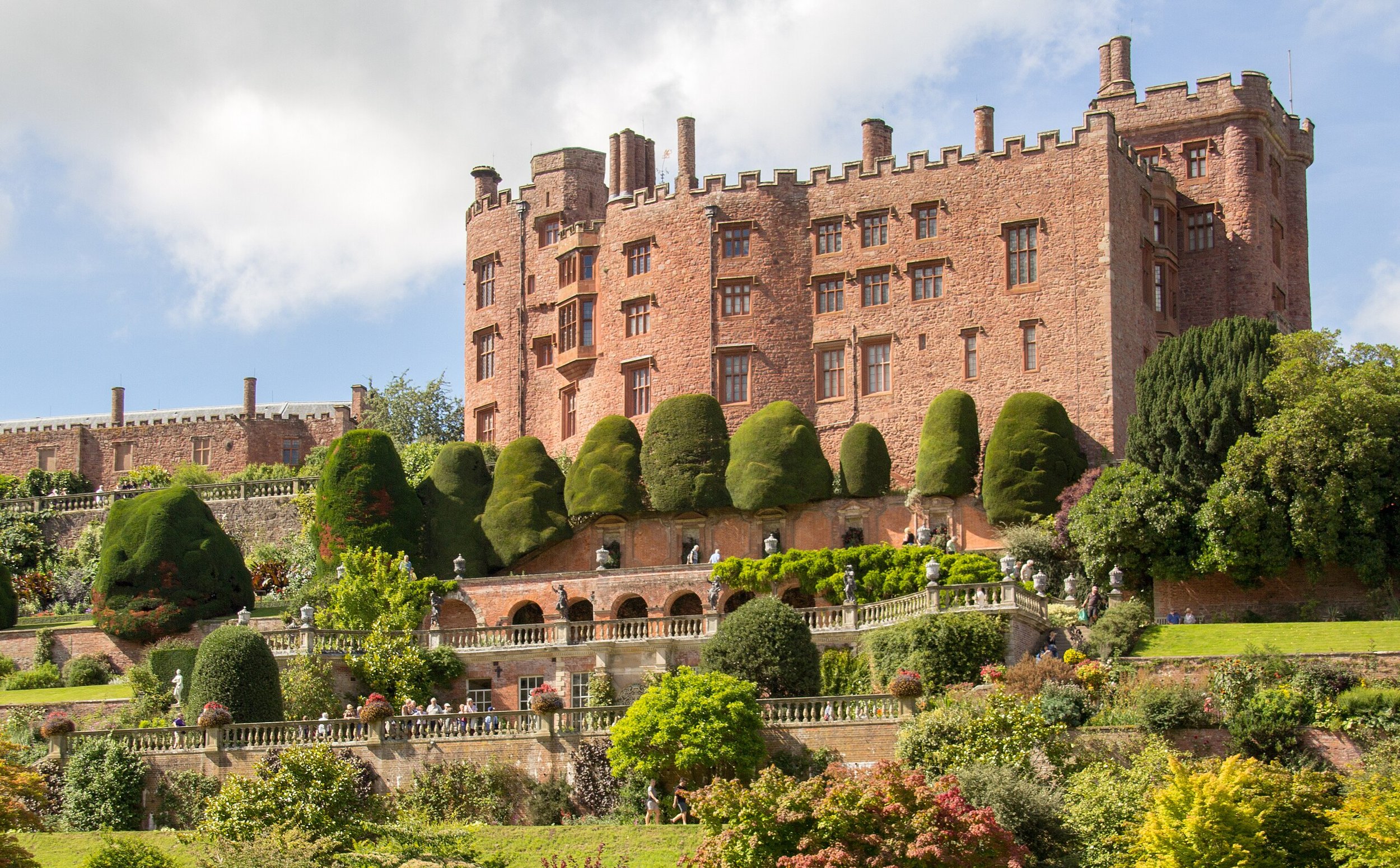
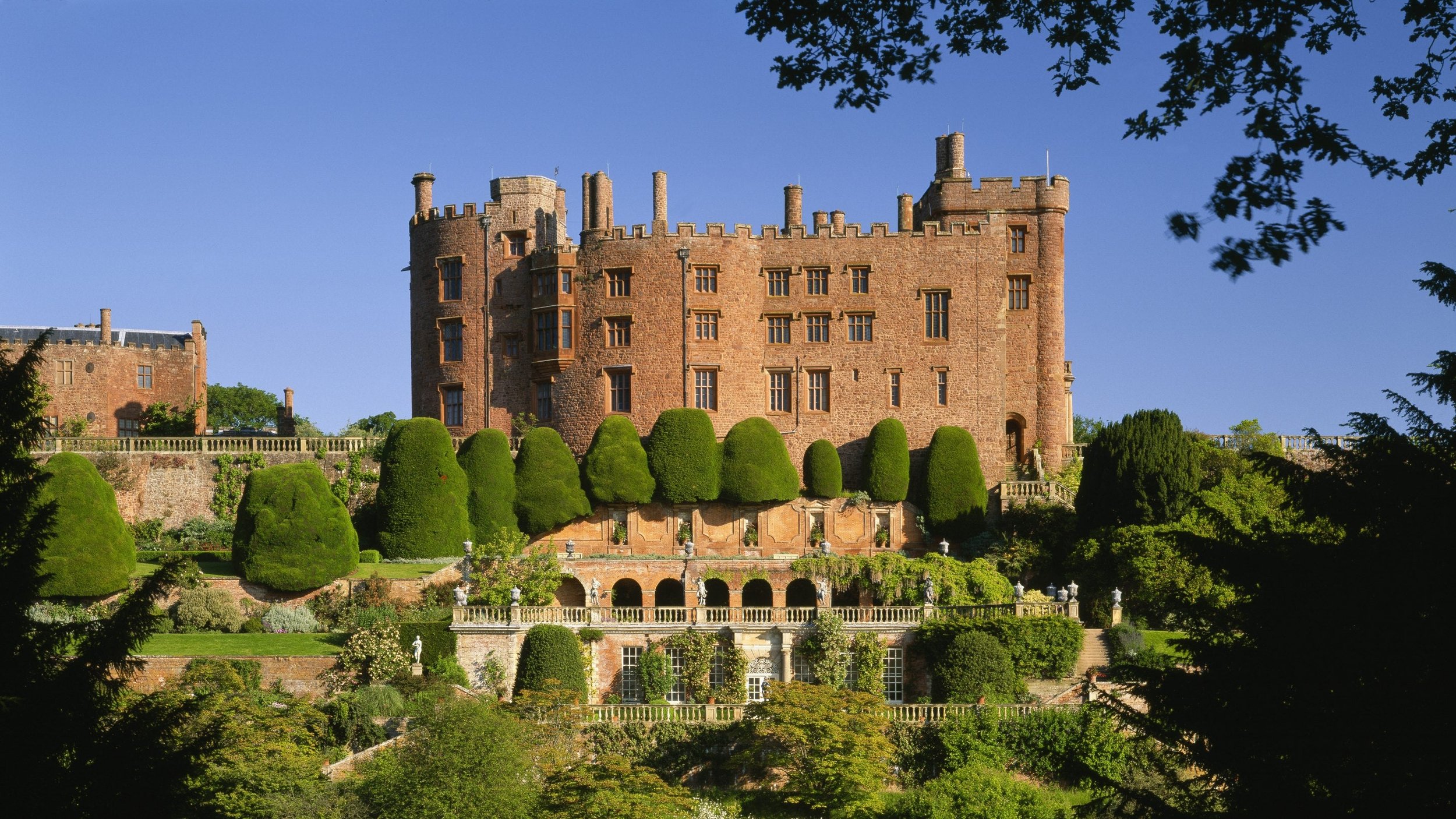
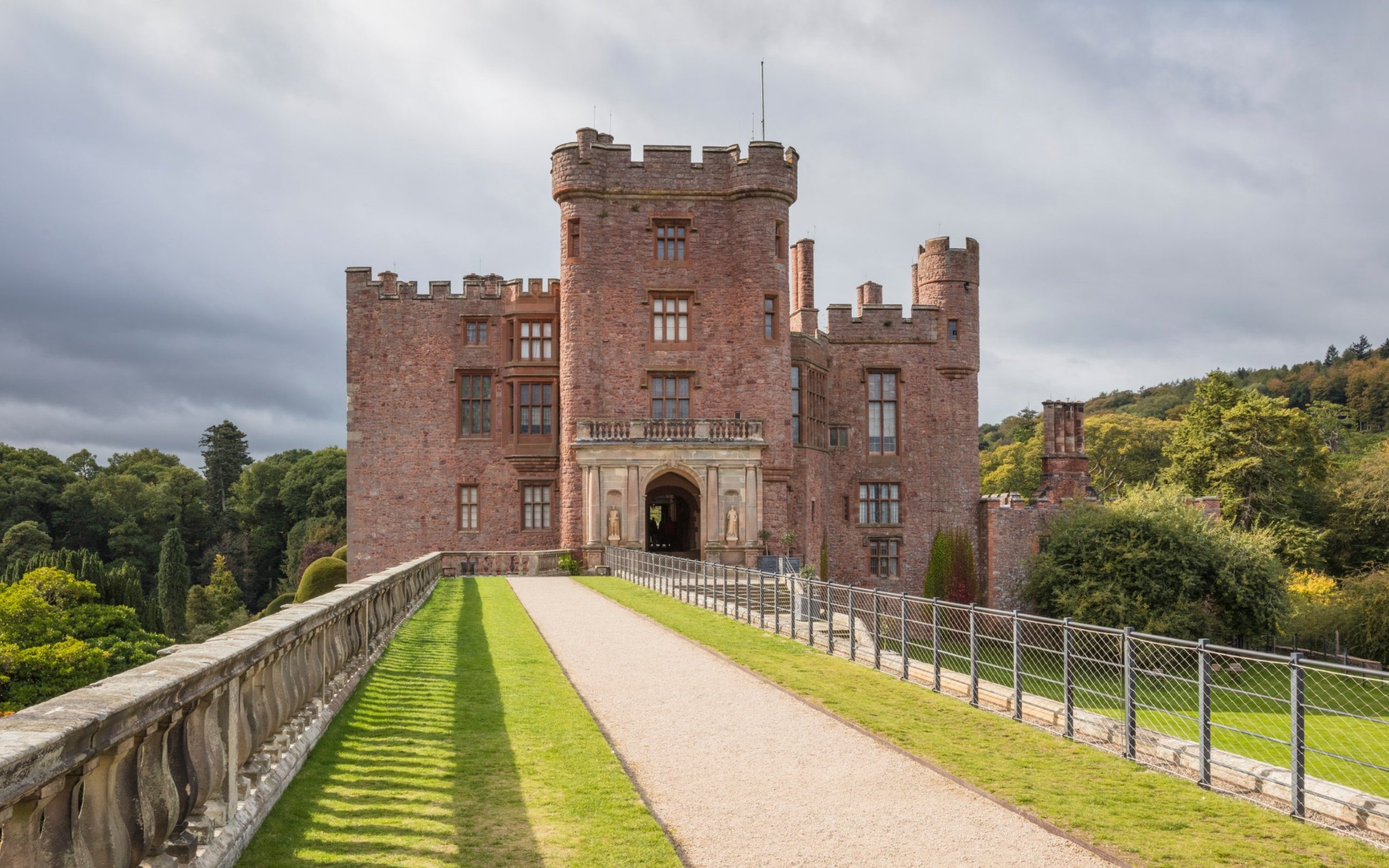
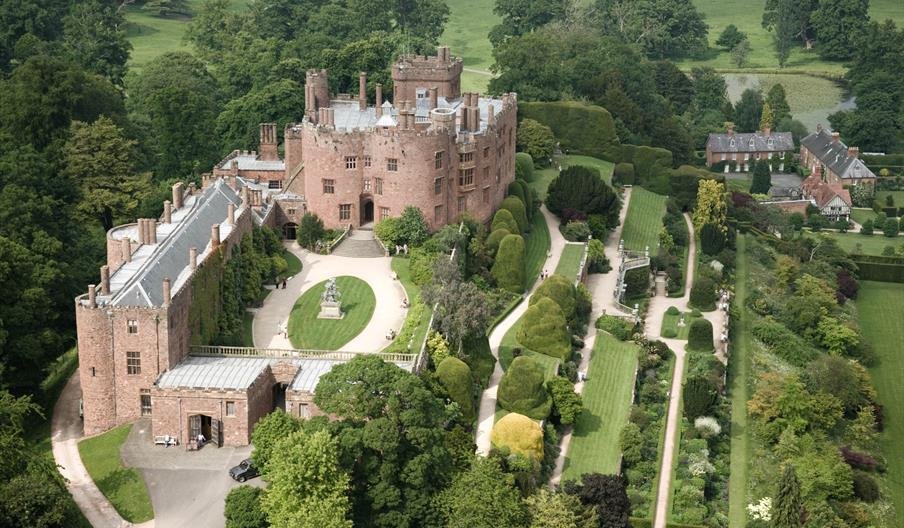
Legends and Stories
This castle has inspired several local legends, many of which have been passed down through oral tradition and visitor accounts.
One popular story involves the so-called “Ghost of the Lady in Black.” According to reports on platforms like TripAdvisor, some visitors and staff claim to have seen a figure dressed in black roaming the castle corridors. These sightings are often associated with one of the former Lady Herberts, though no historical records confirm her identity.
Another frequently mentioned tale concerns the medieval dungeons. Local guides occasionally refer to these areas as being haunted, particularly the older prison cells. However, these stories rely mainly on visitor anecdotes rather than written historical sources.
Additionally, the Clive Museum’s collection has attracted attention from paranormal enthusiasts. Some claim certain artefacts brought from India carry a “curse,” though the National Trust makes no official comment on these accounts. These stories mainly circulate through online reviews and folklore sites rather than documented history.
All legends surrounding it appear to come from modern tourism narratives, with no established medieval myths linked to the site.
Sources include visitor reviews on TripAdvisor and commentary from local guides.
Visiting
Always check the National Trust website for accurate opening times.
Opening Times & Ticket Prices
Castle & Clive Museum open 11:00–15:30 (last admission 14:50; last castle entrance 15:00)
Gardens open 10:00–17:00, with cafés and shop operating slightly shorter hours
Ticket prices (with Gift Aid):
Adult: £18.70
Children (5–17): £9.40 (under 5s free)
Family (2 adults + up to 3 children): £46.80
National Trust members enjoy free admission. Booking ahead is not required.
Directions & Facilities
Address: Welshpool, Powys, SY21 8RF
Transport:
Free main car park (gravel), plus Blue Badge & drop‑off point
Belgian pay‑&‑display in town (Berriew Street)
Accessible vehicle service runs daily (April–September) from 11:00–16:30
One‑mile walk from Welshpool station or bus stops on High Street
On-site facilities:
Courtyard Café, Garden Coffee Shop, Courtyard Shop, Plant Shop, second‑hand bookshop
Accessible toilets near courtyard & in formal garden
Step‑free access in gardens; none in castle interiors
Dog Policy
From March to October, dogs on short lead are allowed in car park and courtyard only
Winter (1 Nov–28 Feb): dogs may also go into woodland, Edwardian Garden, Italianate terraces
Assistance dogs permitted indoors year‑round
Accessibility
Mobile signal is not available inside the castle or museum
Castle is fragile and sensitive; light and visitor flow are managed carefully
Drop‑off points and accessible parking available, though some routes uphill may require assistance
Nearby Attractions
Here are some notable local sites to visit alongside this castle:
Powysland Museum & Welshpool Library
This small canalside museum showcases local archaeology, social history, and canal heritage. It sits beside the Montgomery Canal and offers a clear view of town life from past centuries.
Welshpool & Llanfair Light Railway
A narrow-gauge steam railway running from Welshpool’s Raven Square station to Llanfair Caereinion. The round-trip covers about 16 miles and takes roughly 45 minutes each way.
Montgomery Canal
This 18th-century canal, designated a Site of Special Scientific Interest, is ideal for gentle walks and wildlife spotting (e.g. otters and kingfishers), with picturesque towpaths leading through Welshpool.
Llanerchydol Hall
Located just over 1 mile west of Welshpool, this Grade II* Gothic Revival country house features historic parkland, now open to public walks.
Dolforwyn Castle
A short drive away is this 13th-century royal Welsh ruin built by Llywelyn ap Gruffudd. Though in ruins, it offers insight into native castle architecture.
Leighton Hall Estate
Overlooking the Severn Valley, this Gothic castellated Victorian house and its grounds are not open to visitors but can be admired from the road.
These locations offer a mix of social history, heritage railways, industrial-era landscapes, and architectural ruins, all within easy reach.
Visitor Tips
Arrive early for parking: The main car park is gravel and can become busy on weekends and holidays.
Wear sturdy shoes: The gardens include steep terraces and steps, with some uneven paths.
Check Clive Museum opening times: The museum sometimes closes earlier than the gardens.
Use the garden map: Maps are available at the entrance and help with navigating the multi-level gardens.
Bring water in summer: The steep walkways and open areas can be tiring in hot weather.
Consider the winter dog policy: Dogs can access more areas from November to February.
Accessibility note: Interior rooms have steps and narrow passages, but the garden has accessible routes.
Combine with town visit: Welshpool has shops and cafés within walking distance of the castle.
FAQs
-
Most visitors spend between 2 to 4 hours exploring the castle, museum, and gardens. Allow extra time if you plan to walk in the parkland.
-
Yes, booking is not required. You can buy tickets on arrival. National Trust members enter for free.
-
The gardens have some accessible paths and facilities, but the castle interior has multiple staircases and no lift. A mobility vehicle is available from the car park to the courtyard during summer.
-
Dogs are allowed on leads in the courtyard and parkland year-round. From November to February, dogs can also enter some garden areas. Assistance dogs are allowed throughout.
-
Your ticket includes access to the castle interiors, Clive Museum, terraced gardens, and parkland. Special exhibitions may be included seasonally.
Wrapping it Up
This castle offers a rare combination of medieval history, elegant interiors, and expansive terraced gardens. Visitors can explore fortified walls, stately rooms, and artefacts from British India, all within a well-preserved National Trust property. Its accessible location near Welshpool and additional nearby attractions make it a popular destination for history enthusiasts, garden lovers, and families. With well-maintained facilities and clear visitor information, it provides a straightforward and enjoyable visit for all age groups.
Sources
National Trust
Official information on opening times, ticket prices, facilities (e.g., café, shop, accessibility), free parking, and castle & museum access.
https://www.nationaltrust.org.uk/visit/wales/powis-castle-and-garden
National Trust
Description of the Italianate terraces, Edwardian Formal Garden, Wilderness walk, Fountain Garden, and ancient yew hedges.
https://www.nationaltrust.org.uk/visit/wales/powis-castle-and-garden/visiting-the-garden-at-powis-castle
Visit Wales
Confirms National Trust care since 1952; overview of the Clive Museum South Asian collection, castle history, and garden features.
https://www.visitwales.com/attraction/castle/powis-castle-and-garden-528187
Garden Access Statement (2023)
Accessibility details: disabled parking, accessible toilets, access vehicle, mobile signal limitations, and dog restrictions.
https://nt.global.ssl.fastly.net/binaries/content/assets/website/national/regions/wales/places/powis-castle-and-garden/pdf/powis-castle-and-garden-_property_access_statement-2023.pdf
Wikipedia
Context on the Clive Museum, collection controversies, provenance research, and National Trust interpretation efforts.
https://en.wikipedia.org/wiki/Powis_Castle




Aberystwyth Castle is a striking example of a coastal fortress built during the medieval period in Wales. It's found in the town of Aberystwyth, Ceredigion.